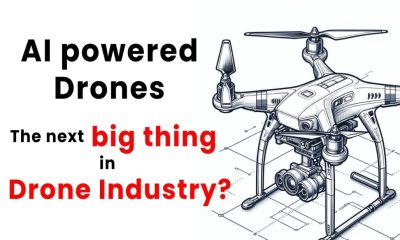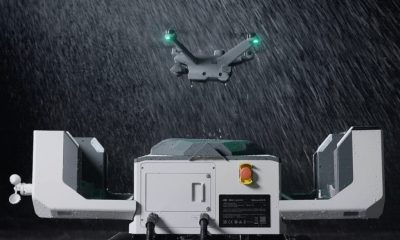Drone News
Infrastructure Inspection with Drones
Table Of Contents

Infrastructure Inspection with Drones Powered by AI
Infrastructure Inspection with Drones is a paradigm-shifting development that is fast becoming a standard in the fields of civil engineering, construction, and maintenance. Drones, equipped with advanced imaging technology and artificial intelligence, are transforming traditional methods of inspecting infrastructure, providing safer, more efficient, and highly precise solutions.
The Evolution of Infrastructure Inspection

Historically, infrastructure inspection has been a time-consuming, costly, and often dangerous task. It required trained personnel to physically inspect structures, sometimes in challenging or hazardous conditions. Over the years, various methods have been employed to streamline the process, including the use of cherry pickers, harnesses, and ropes for difficult-to-reach areas.
With the advent of drone technology, however, the process of infrastructure inspection has been revolutionized. Drones, capable of reaching heights and angles that were once near impossible, have mitigated the need for inspectors to put themselves at risk. More so, the incorporation of advanced imaging technologies and AI into drones has elevated the accuracy and efficiency of infrastructure inspection to unprecedented levels.

Incorporation and Impact on the Industry
Drone technology has seamlessly integrated into the infrastructure inspection process. Equipped with high-resolution cameras and sensors, drones can capture detailed images and videos of structures. Moreover, with AI capabilities, drones can analyze these images in real-time, detecting anomalies such as cracks, corrosion, or other structural defects.
The application of drones in infrastructure inspection has been vast. From inspecting power lines and wind turbines to monitoring bridges and high-rise buildings, drones have proven to be an invaluable tool. Their ability to quickly and safely inspect structures has resulted in significant time and cost savings, improved maintenance schedules, and, most importantly, enhanced safety.
Key Players and Current Utilization
Several drone technology companies and service providers have recognized the potential of drones in infrastructure inspection. DJI, a leading drone manufacturer, has created drones specifically designed for inspections, such as the Matrice 300 RTK. This drone is equipped with AI capabilities and can carry various sensors to collect and analyze inspection data.
SkySpecs, a drone service provider, offers autonomous drone inspection services for wind turbines, while companies like PrecisionHawk provide drone-based inspection services for various sectors, including energy, agriculture, and infrastructure.
The AI Technology Fueling Drone-Based Infrastructure Inspection
The integration of artificial intelligence (AI) technology with drone operations has been transformative for infrastructure inspection. A synergy of machine learning algorithms, image processing, and advanced sensor technology enables drones to conduct autonomous and precise inspections.
Machine Learning and Data Analysis
Machine learning, a branch of AI, is central to processing and interpreting the massive amounts of data collected during drone inspections. Drones capture high-resolution images and videos, which machine learning models then analyze to identify potential structural issues.
Machine learning models can be trained to recognize signs of damage or wear and tear, such as cracks, rust, or deformations. These models improve over time, learning from each inspection to increase their accuracy and predictive capabilities.
Computer Vision and Image Processing
Computer vision, another facet of AI, plays a crucial role in infrastructure inspection with drones. This technology enables drones to understand and interpret visual data.
Using image processing techniques, computer vision can enhance raw visual data, improve image quality, and filter out noise. This processing makes it easier for machine learning models to analyze the images and detect any anomalies accurately.
Sensors and IoT
Drones used for infrastructure inspection often come equipped with various advanced sensors. These sensors can include thermal cameras, LIDAR, ultrasonic sensors, and more. These sensors collect additional data that can be crucial for inspection, such as thermal data to detect heat leaks or LIDAR data to create detailed 3D models of the structure.
Internet of Things (IoT) technology often complements these sensor systems. IoT connectivity allows drones to relay data in real-time to remote servers or cloud platforms. This real-time data transmission enables immediate analysis and faster decision-making.
Autonomous Navigation
AI is also crucial for the autonomous navigation of drones during inspections. Drones use AI algorithms to follow pre-determined flight paths, adjust to wind conditions, avoid obstacles, and safely land. This level of autonomy reduces the need for human operators and makes the inspection process more efficient.
The Future of Infrastructure Inspection with Drones
The future of infrastructure inspection with drones is full of possibilities. As drone technology and AI continue to advance, drones will become even more capable and efficient at inspecting infrastructure.
One future development could be the use of swarm drones for large-scale inspections. This would involve multiple drones working together to inspect a large structure, significantly reducing inspection time.
Moreover, with advancements in AI, predictive maintenance could become a reality. Drones could identify potential issues before they become significant problems, enabling proactive maintenance and saving resources.
Conclusion
Infrastructure Inspection with Drones is proving to be a revolutionary shift in the way we maintain and manage our built environment. This shift is not only bringing about efficiencies and safety improvements but is also setting the stage for a future where drones become an indispensable part of infrastructure management.










![Upcoming Drone Regulations in Canada ([year])](https://www.flyeye.io/wp-content/uploads/2024/07/drone-regulation-canada-400x240.jpg)
![Upcoming Drone Regulations in Canada ([year])](https://www.flyeye.io/wp-content/uploads/2024/07/drone-regulation-canada-80x80.jpg)